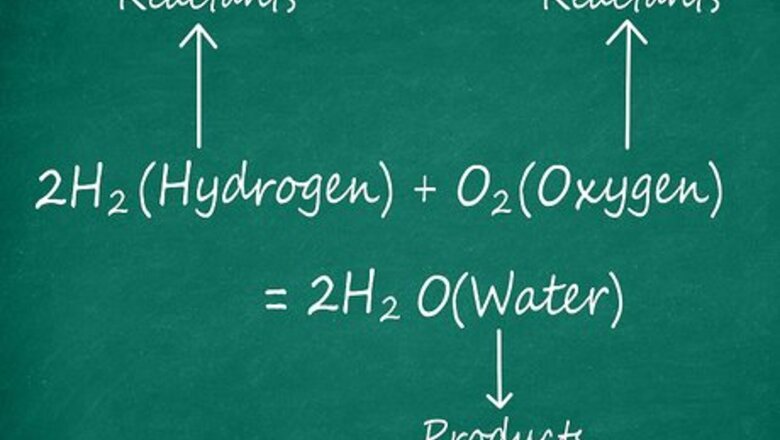
views
Solving Enthalpy Problems
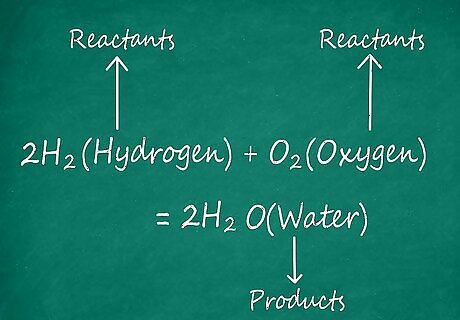
Determine your reaction’s products and reactants. Any chemical reaction involves two categories of chemicals — products and reactants. Products are the chemicals created by the reaction, while reactants are the chemicals that interact, combine, or break down to make the product. In other words, the reactants of a reaction are like the ingredients in a recipe, while the products are like the finished dish. To find ∆H for a reaction, first identify its products and reactants. As an example, let’s say we want to find the enthalpy of reaction for the formation of water from hydrogen and oxygen: 2H2 (Hydrogen) + O2 (Oxygen) → 2H2O (Water). In this equation, H2 and O2 are the reactants and H2O is the product.
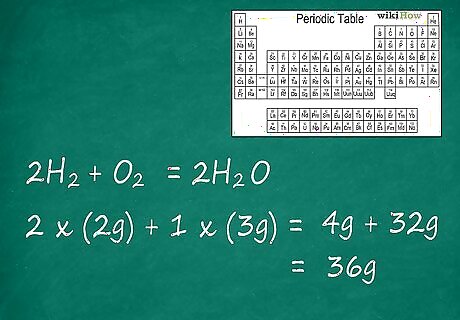
Determine the total mass of the reactants. Next, find the masses of your reactants. If you don't know their masses and aren't able to weigh the reactants in a scientific balance, you can use their molar masses to find their actual masses. Molar masses are constants that can be found on standard periodic tables (for individual elements) and in other chemistry resources (for molecules and compounds). Simply multiply the molar mass of each reactant by the number of moles used to find the reactants' masses. In our water example, our reactants are hydrogen and oxygen gases, which have molar masses of 2g and 32 g, respectively. Since we used 2 moles of hydrogen (signified by the "2" coefficient in the equation next to H2) and 1 mole of oxygen (signified by no coefficient next to O2), we can calculate the total mass of the reactants as follows:2 × (2g) + 1 × (32g) = 4g + 32g = 36g
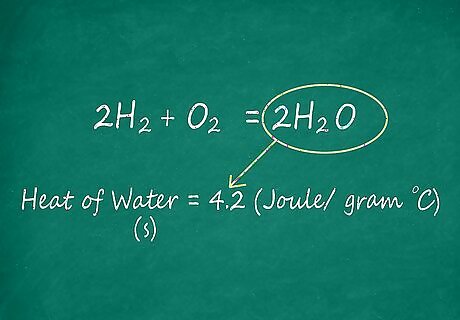
Find the specific heat of your product. Next, find the specific heat of the product you're analyzing. Every element or molecule has a specific heat value associated with it: these values are constants and are usually located in chemistry resources (like, for instance, in tables at the back of a chemistry textbook). There are several different ways to measure specific heat, but for our formula, we'll use value measured in the units joule/gram °C. Note that if your equation has multiple products, you'll need to perform the enthalpy calculation for the component reaction used to produce each product, then add them together to find the enthalpy for the entire reaction. In our example, the final product is water, which has a specific heat of about 4.2 joule/gram °C.
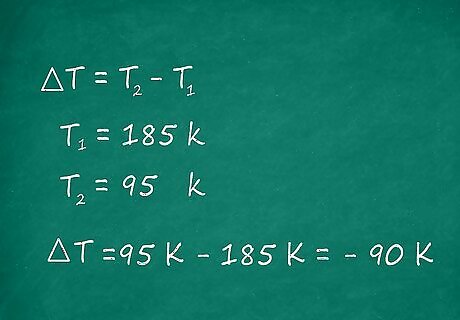
Find the difference in temperature after the reaction. Next, we'll find ∆T, the change in temperature from before the reaction to after the reaction. Subtract the initial temperature (or T1) of the reaction from the final temperature (or T2) to calculate this value. As in most chemistry work, Kelvin (K) temperatures should be used here (though Celsius (C) will give the same results). For our example, let's say that our reaction was 185K at its very start but had cooled to 95K by the time it finished. In this case, ∆T would be calculated as follows:∆T = T2 – T1 = 95K – 185K = -90K
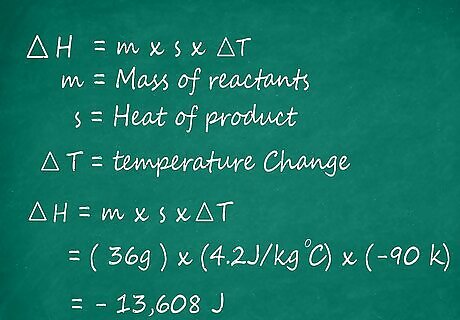
Use the formula ∆H = m x s x ∆T to solve. Once you have m, the mass of your reactants, s, the specific heat of your product, and ∆T, the temperature change from your reaction, you are prepared to find the enthalpy of reaction. Simply plug your values into the formula ∆H = m x s x ∆T and multiply to solve. Your answer will be in the unit of energy Joules (J). For our example problem, we would find the enthalpy of reaction as follows:∆H = (36g) × (4.2 JK-1 g-1) × (-90K ) = -13,608 J
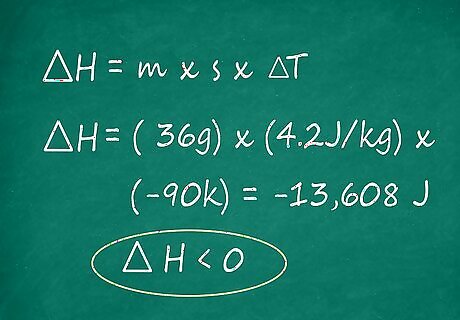
Determine whether your reaction gains or loses energy. One of the most common reasons that ∆H is calculated for various reactions is to determine whether the reaction is exothermic (loses energy and gives off heat) or endothermic (gains energy and absorbs heat). If the sign of your final answer for ∆H is positive, the reaction is endothermic. On the other hand, if the sign is negative, the reaction is exothermic. The larger the number itself is, the more exo- or endo- thermic the reaction is. Beware strongly exothermic reactions — these can sometimes signify a large release of energy, which, if rapid enough, can cause an explosion. In our example, our final answer is -13608 J. Since the sign is negative, we know that our reaction is exothermic. This makes sense — H2 and O2 are gasses, while H2O, the product, is a liquid. The hot gasses (in the form of steam) have to release energy into the environment in the form of heat to cool to the point that they can form liquid water, meaning that the formation of H2O is exothermic.
Estimating Enthalpy
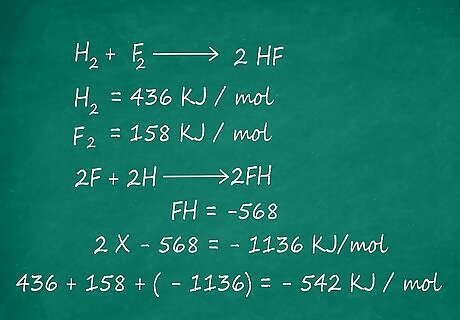
Use bond energies to estimate enthalpy. Nearly all chemical reactions involve forming or breaking bonds between atoms. Since, in a chemical reaction, energy can be neither destroyed nor created, if we know the energy required to form or break the bonds being made (or broken) in the reaction, we can estimate the enthalpy change for the entire reaction with high accuracy by adding up these bond energies. For example, let's consider the reaction H2 + F2 → 2HF. In this case, the energy required to break the H atoms in the H2 molecule apart is 436 kJ/mol, while the energy required for F2 is 158 kJ/mol. Finally, the energy needed to form HF from H and F is = -568 kJ/mol. We multiply this by 2 because the product in the equation is 2HF, giving us 2 × -568 = -1136 kJ/mol. Adding these all up, we get: 436 + 158 + -1136 = -542 kJ/mol.
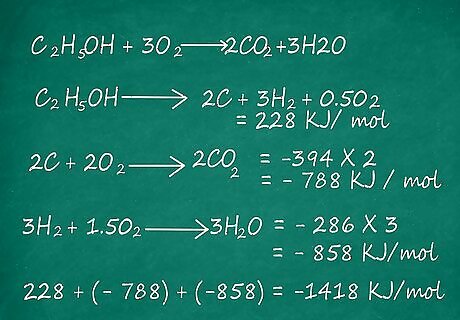
Use enthalpies of formation to estimate enthalpy. Enthalpies of formation are set ∆H values that represent the enthalpy changes from reactions used to create given chemicals. If you know the enthalpies of formation required to create products and reactants in an equation, you can add them up to estimate the enthalpy much as you would with bond energies as described above. For example, let's consider the reaction C2H5OH + 3O2 → 2CO2 + 3H2O. In this case, we know the enthalpies of formation for the following reactions:C2H5OH → 2C + 3H2 + 0.5O2 = 228 kJ/mol2C + 2O2 → 2CO2 = -394 × 2 = -788 kJ/mol 3H2 + 1.5 O2 → 3H2O = -286 × 3 = -858 kJ/mol Since we can add these equations up to get C2H5OH + 3O2 → 2CO2 + 3H2O, the reaction we're trying to find the enthalpy for, we can simply add up the enthalpies of the formation reactions above to find the enthalpy of this reaction as follows: 228 + -788 + -858 = -1418 kJ/mol.
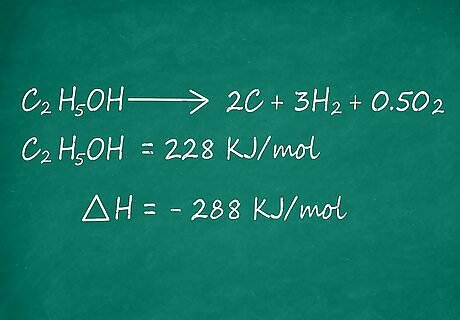
Don’t forget to switch signs when reversing equations. It's important to note that when you use enthalpies of formation to calculate the enthalpy of a reaction, you need to reverse the sign of the enthalpy of formation whenever you reverse the equation of the component reaction. In other words, if you have to turn one or more of your formation reaction equations backwards in order to get all of your products and reactants to cancel properly, reverse the sign on the enthalpies of the formation reactions you had to flip. In the example above, notice that the formation reaction we use for C2H5OH is backwards. C2H5OH → 2C + 3H2 + 0.5O2 shows C2H5OH breaking down, not being formed. Because we turned the equation around in order to get all of the products and reactants to cancel properly, we reversed the sign on the enthalpy of formation to give us 228 kJ/mol. In reality, the enthalpy of formation for C2H5OH is -228 kJ/mol.
Observing Enthalpy Changes Experimentally
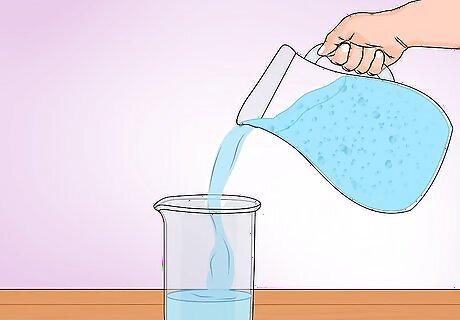
Grab a clean container and fill it with water. It's easy to see the principles of enthalpy in action with a simple experiment. To make sure that the reaction in your experiment will take place without any foreign contamination, clean and sterilize the container that you plan to use. Scientists use special closed containers called calorimeters to measure enthalpy, but you can achieve reasonable results with any small glass jar or flask. Regardless of the container you use, fill it with clean, room-temperature tap water. You'll also want to conduct the reaction somewhere indoors with a cool temperature. For this experiment, you'll want a fairly small container. We'll be testing the enthalpy-altering effects of Alka-Seltzer on water, so the less water used, the more obvious the temperature change will be.
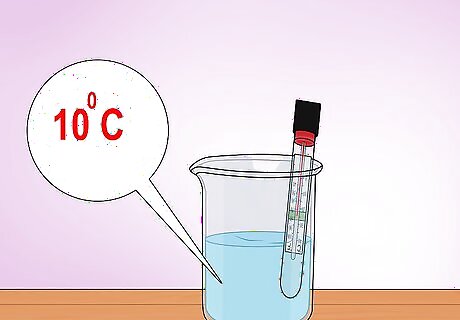
Insert a thermometer into the container. Grab a thermometer and set it in the container so that the temperature-reading end sits below the water level. Take a temperature reading of the water — for our purposes, the temperature of the water will represent T1, the initial temperature of the reaction. Let's say that we measure the temperature of the water and find that it's exactly 10 degrees C. In a few steps, we'll use this sample temperature reading to demonstrate the principals of enthalpy.
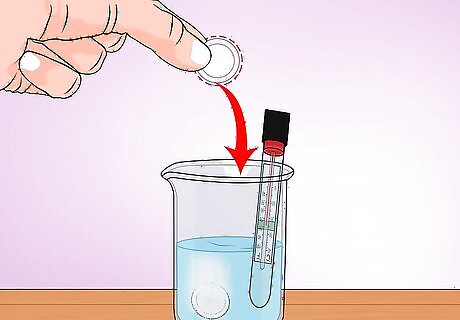
Add one Alka-Seltzer tablet to the container. When you're ready to start the experiment, drop a single Alka-Seltzer tablet into the water. You should notice it immediately start to bubble and fizz. As the tablet dissolves in the water, it breaks down into the chemicals bicarbonate (HCO3) and citric acid (which reacts in the form of hydrogen ions, H). These chemicals react to form water and carbon dioxide gas in the reaction 3HCO3 + 3H → 3H2O + 3CO2.
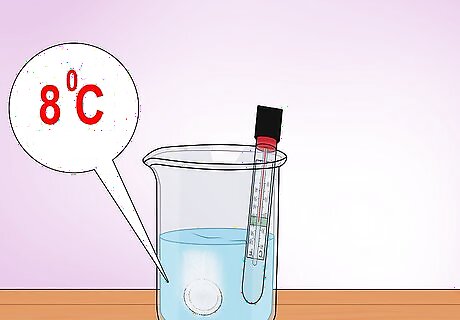
Measure the temperature when the reaction finishes. Monitor the reaction as it proceeds — the Alka-Seltzer tablet should gradually dissolve. As soon as the tablet finishes its reaction (or seems to have slowed to a crawl), measure the temperature again. The water should be slightly colder than before. If it's warmer, the experiment may have been affected by an outside force (like, for instance, if the room you're in is especially warm). For our example experiment, let's say that the temperature of the water is 8 degrees C after the tablet has finished fizzing.
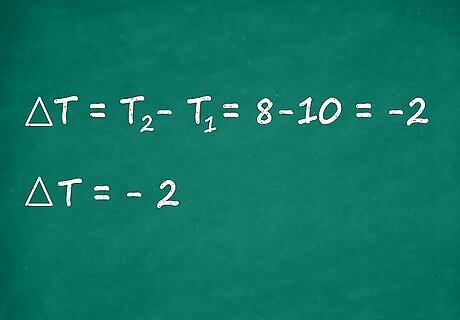
Estimate the enthalpy of the reaction. In an ideal experiment, when you add the Alka-Seltzer tablet to the water, it forms water and carbon dioxide gas (the latter of which can be observed as fizzing bubbles) and causes the temperature of the water to drop. From this information, we would expect the reaction to be endothermic — that is, one that absorbs energy from the surrounding environment. The dissolved liquid reactants need extra energy to make the jump to the gaseous product, so it takes energy in the form of heat from its surroundings (in this case, water). This makes the water's temperature fall. In our example experiment, the temperature of the water fell two degrees after adding the Alka-Seltzer. This is consistent with the sort of mildly endothermic reaction we'd expect.




















Comments
0 comment